Hands-on with APB
Could it make the possibility of a GTA MMO irrelevant?
Not everyone is good with colours though, and design might not be your thing, in which case the in-game economy spreads to auction houses where designs, clothing, weaponry and triumphant sound files for your victims to endure upon the moment of their death can be purchased. It’s easy to forget sometimes, but this is an MMO – mailboxes abound, and elsewhere in the Social District you’ll find nightclubs where you and your brethren can /dance the night away.
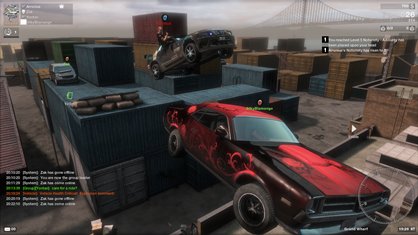
In keeping with APB’s desire to create a feeling of in-game celebrity, statues of successful players who have won daily, weekly and monthly leagues will take centre stage. You’ll no doubt be gazing at their plinths wistfully as you corral your troops, or prepare to leap into the fray with a buddy who’s already out in the districts ridding the streets of crime, or doing their best to riddle them with it.
As you enter a 100-player server there’ll predictably be a fair degree of activity on the streets: hoodlums tossing pedestrian bodies in their wake, Enforcers leaping off ramps with their red and blue lights ablaze, and all that jazz. An important thing to note is that until a crimefighter has been match-made against you (or until you’ve had an APB call if you’re the law) then you won’t be able to kill any human players with weaponry. You can run people over just dandy, mainly because it’s hilarious, but a bullet free-for-all would rob the game of that vital commit crime-chasey chase dynamic.
As an Enforcer it’s down to you to wander over to a terminal that will conjure up your personal car and patrol the streets or react to match-making call-outs from the APB mainframe. For the opposing side petty crime might be the order of the day, or perhaps a sequence of tasks from an NPC contact – mission givers that instantly bring the contact system of City of Heroes to mind. Each contact represents a different organisation, and the further you level through each underworld outfit the better cars and weapons that are made available to you.
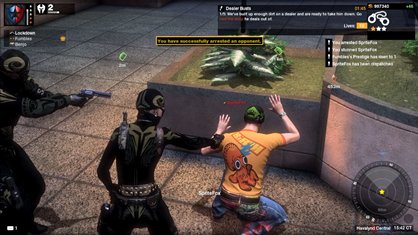
The controls of the game will be familiar to anyone who’s ever fired a gun in simulated anger: left-click to fire, WASD to move, right-click to bring the camera down over the gun, C to crouch... it’s simplicity in itself. For the criminals a typical string of tasks would begin with clear crimes – burning a certain number of doorways for example, stealing a collection of scattered items or half-inching a car and taking it to a local dealer. You’re armed with your main weapon, a handgun and however many grenades you’ve brought into the fray – although the power of a car crushing a rival player in a side-on skid off a rooftop can never be underestimated.
In terms of providing targets to use these on though, it all depends on your gang’s kill/death ratios, how far up the game’s unlock ladders you’ve all gone and the notoriety you’ve all built up over the past few minutes in the game. This will then matchmake Enforcers that are the closest fit (balancing both numbers and skill levels) and send them after you.
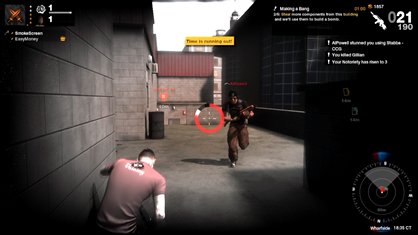
Despite the veneer of Cops and Robbers, most of the challenges are instantly familiar: assaults on specific areas, king of the hill, protect the VIP, team deathmatch – essentially short bursts of those same modes that have made online gaming simultaneously great and samey over the past decade.
Sign up to the GamesRadar+ Newsletter
Weekly digests, tales from the communities you love, and more
Here, however, each burst is intermingled with hectic chases from location to location – and if one faction arrives before another then they can do their best to set up shop for the battle ahead barricading areas with stolen cars, and taking up the best sniper positions. After this burning vehicles unexpectedly plow through tunnels full of cops with hilarious results, Enforcers dazzle their prey with stun grenades and arrest them (forcing them out of the game for longer than the usual respawn time) and bullets fill the air.
Once the mission chain is over, due to a faction victory or the time limit being hit, plaudits and cash are doled out to the worthy and battle ceases. Everyone stands, once more unable to shoot each other, and share a happily awkward post-action breather before going their separate ways. Some choose to /dance.
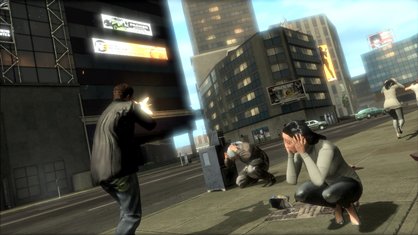
The highlight during our playtest as a criminal came when we tormented a defeated Enforcer with an exploratory /wave amidst the burning wreckage of our previous dealings. There was a pause of a few seconds as our foe worked out how to return a friendly salutation, as we watched a friend steal a sports car 50 metres behind him and accelerate toward his back.
We estimate the Enforcer got through around four frames of his happy waving animation before his broken ragdoll somersaulted skywards. We could h have died laughing. It’s these moments of unscripted hilarity that APB frequently delights with. Your first hours within its districts will be happy ones indeed, but as to whether the game will retain you for the hundreds of hours that a successful MMO expects of its players is still an unknown quantity. An opening problem is an unfair, yet important, consideration: APB is not Grand Theft Auto IV.
This is persnickety, but almost everyone who goes into APB will have experienced Niko Bellic’s adventures – and when you first play the game there’s a mental barrier in that the Grand Theft Auto mechanics you expect either aren’t present or aren’t (in APB’s beta at least) as honed. It seems strange that you can’t shoot a driver through a windshield, it annoys that the car-exit animations are laborious in comparison to Rockstar’s, the lack of motorbikes is evident, and the grungy character of Liberty City is absent in the wiped-clean exteriors of San Paro.
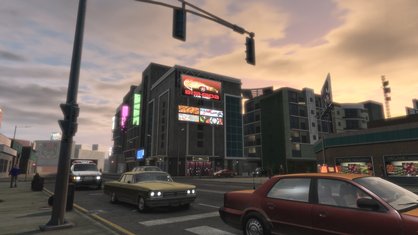
Most of these issues could be cleared up as the game develops over the months and years post-release, of course, but we can’t sit here and pretend that we didn’t feel sad when APB’s burning cars didn’t blow up in the fashion to which we’re accustomed. Crimes such asramraidingand mugging too seem somewhat mechanical and, we dare say, MMO-ey. Shallow and unthinking criticisms we know, but we can’t deny what our brains told us.


